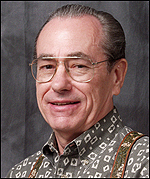Robert Bayuzick, who had experiments conducted on three separate flights of the space shuttle Columbia while he was a professor of chemical engineering and director of materials science at Vanderbilt University, died Feb. 8, 2013, in Nashville. He was 75.

Bayuzick’s research was directed toward materials processing under microgravity conditions, with a particular emphasis on the structure and properties of alloys resulting from deep cooling through containerless solidification.
Bayuzick served on the lead team working on TEMPUS, an electromagnetic levitation facility for the containerless processing of metallic samples in microgravity aboard Columbia. He was a member of the National Research Council’s Committee on Microgravity Research and he served on a three-member NRC task group on Institutional Arrangements for Space Station Research.
Scientists melted and then cooled metal samples aboard the space shuttle in hopes of eventually benefiting industries on Earth. The researchers worked by remote control from Marshall Space Flight Center in Huntsville, Ala. After being melted, the metals were cooled to below freezing inside TEMPUS. Bayuzick said in a 1997 Los Angeles Times article that he was pleased with how his tests on zirconium – found in ceramic and refractory compounds – turned out.
Bayuzick received many honors and awards throughout his tenure on the Vanderbilt engineering faculty from 1969 to his retirement in 2003, when he became professor emeritus of chemical engineering and professor emeritus of materials science. One notable honor was NASA’s Public Service Medal for “exceptional contributions to the mission of NASA” in 1992.
Known affectionately as Buzzy by colleagues and students, former engineering school dean Kenneth F. Galloway said, “Buzzy was loved by his students and uniformly admired and respected by all the engineering faculty.”
James Wert, George A. Sloan Professor of Metallurgy, emeritus, and professor emeritus of mechanical engineering at Vanderbilt, recruited Bayuzick as a graduate student and hired him as a faculty member. “I was impressed with his brains and his attitude. He was an all-around great guy.” Wert said he and Bayuzick worked together when Bayuzick was a metallurgy technician in the Bettis Atomic Power Lab at Westinghouse Corporation on fuel for the world’s first nuclear-powered submarine U.S.S. Nautilus and the nuclear aircraft carrier U.S.S. Enterprise.
“Buzzy loved life, science, and his students,” said William Hofmeister, director, Center for Laser Applications, University of Tennessee Space Institute in Tullahoma, Tenn. Hofmeister earned a Ph.D. in materials science at Vanderbilt in 1987 under the direction of Bayuzick.
With Bayuzick, Hofmeister developed a method to determine nucleation kinetics on levitated metallic melts using statistical techniques. This methodology was used for the evaluation of data from the space flight experiments.
“I could not have had a better mentor. He gave us an ethical example to live by,” Hofmeister said. “Thinking of Bob, we can reflect Wordsworth’s lines from Tintern Abby: ‘On that best portion of a good man’s life, His little, nameless, unremembered, acts Of kindness and of love.’”
Bayuzick was the author of 83 publications, 44 invited conference presentations, 63 contributed conference presentations, and delivered eight invited lectures. He was a visiting research professor in 1977-1978 at Cambridge University in England. From 1991 to 1992 he was a visiting senior scientist at NASA headquarters.
Bayuzick was born in Braddock, Penn. He received a bachelor’s degree in metallurgical engineering from the University of Pittsburgh and a master’s degree in physical metallurgy from the University of Denver. He earned a Ph.D. in materials science at Vanderbilt University.
Bayuzick is survived by his wife, Jeannette Lyle Bayuzick; his daughters, Carrie (Gary) Hargis and Kellie (Bob) Kidd, and five grandchildren all of Nashville; a sister, two nieces and nephews, all from Denver, Colo.